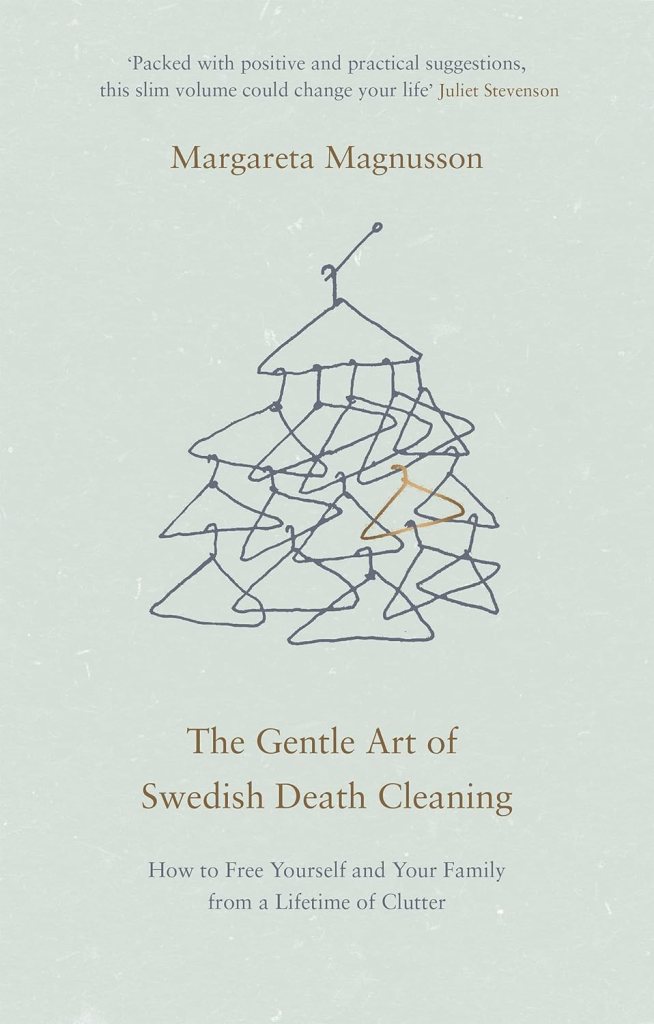The art of death cleaning (Döstädning in Swedish) is actually about decluttering, and organising your affairs generally, before you die, rather than leaving it for someone else to do afterwards. Margareta Magnusson’s The Gentle Art of Swedish Death Cleaning: How to Free Yourself and Your Family from a Lifetime of Clutter (2017) provides an inspirational, if not particularly rigorous, approach to an important issue most people fail to contemplate, leaving their families with a headache. Her suggestions are based on the experience of death cleaning for herself and for her parents and husband. She clearly caught a mood, as the book has been turned into a television series.
Death cleaning allows us to acknowledge an unhealthy tendency to hoard, and to recognise what is important and what is trivial. It is not easy, as Magnusson acknowledges, because one’s possessions are a part of one’s identity and there is very often an emotional investment. But it is therapeutic, and helps us to assess our priorities. It is a way of maintaining a level of control in our lives, especially valuable if health and circumstances limit our control elsewhere.
Anyway, if we don’t let go of something, it will eventually let go of us and still be here for someone else to sort out, and they might not do it with the same care we would, especially if there is much to sift and limited lime available. Taking the process into our own hands minimises risk of important items being discarded. It’s even worse if those clearing out are grieving, and every item reminds them of the deceased. It can be a distressing activity. Why not spare them as much as possible by doing it ourselves?
If you don’t want to leave having to deal with all your possessions to them, you’ll take responsibility. There may be rare exceptions to the eventual need for disposal: some people never seem to throw anything away – Andy Warhol and Bob Dylan spring to mind. So, if you are a famous artist you might want to characterise your belongings as an archive and keep adding to it. If what you leave is worth money your heirs may thank you, but for most of us the chances are it will be mostly crap, and they won’t.
As for the process, do it methodically, rather than rush around willy-nilly. Tackle a room at a time and categorise the contents. Start with the easy stuff (clothes for example, or duplicate crockery) and defer items with emotional significance, which can bog the process down. Items can be disposed of by giving them to family and friends as presents (being aware that we might be foisting them on relatives too diffident to say they don’t want them), donated to charity, sold, recycled or binned. Buy a good shredder. Record information executors will need, then they won’t have to try to second-guess one’s wishes. Computer files can be rationalised and passwords recorded.
We might keep some items of personal relevance to us but of no interest to anyone else, and these can be so labelled, then thrown away with a clear conscience by one’s heirs when the time comes. Items intended for family members can be marked up. Collections of photographs can be digitised and shared. What is left can be organised, for our convenience and that of others later. Death cleaning also allows one to reconnect with items taken for granted over the years.
Decluttering might not be about death. Perhaps we need to downsize because of changed circumstances, and we might find tackling a big task much harder than if it had been done earlier, when we were more capable. Whatever the reason, Magnusson suggests starting no later than our mid-sixties to give ourselves time to do a thorough job without having to rush. It is possible to leave it too late and take one’s leave with the task incomplete. That of course could happen at any age, so it is best to keep the problem in mind as early as possible.
It might be even worse than leaving relatives with a big job; there have been numerous instances of psychical researchers and ufologists dying and having their files binned, and I am sure this extends to other fields. Valuable data are lost because those responsible for winding up the deceased’s affairs have no idea what to do with a collection, the significance of which they are unaware, particularly if there is no obvious monetary value. Those potentially in this situation should ensure a mechanism exists for flagging up where to send research documentation.
Death cleaning can be short-circuited to a large extent by deciding against the accumulation of possessions. There is something to be said for minimalist living, if one can manage it. In a consumer society it is not always easy to ignore the siren call of commerce persuading us to buy, but it is worth bearing in mind that disposing of something is harder than not having it in the first place. It’s nice not to have to bother with a lot of objects needing to be cleaned and cared for. Being surrounded by things we don’t need is a drag on the spirit.
Death cleaning is all common sense really, and there is nothing particularly original here, but sometimes we need a little push to begin something, and this book can help us to overcome inertia in deciding what we no longer need. It injects humour into what could be a morbid process and Magnusson is a pleasant, and never hectoring, companion. The title may put off some potential readers, but it does focus the mind, emphasising the importance of preparing for that end state, however little we may welcome its arrival. Death may be decades off, but it is best to be prepared.

